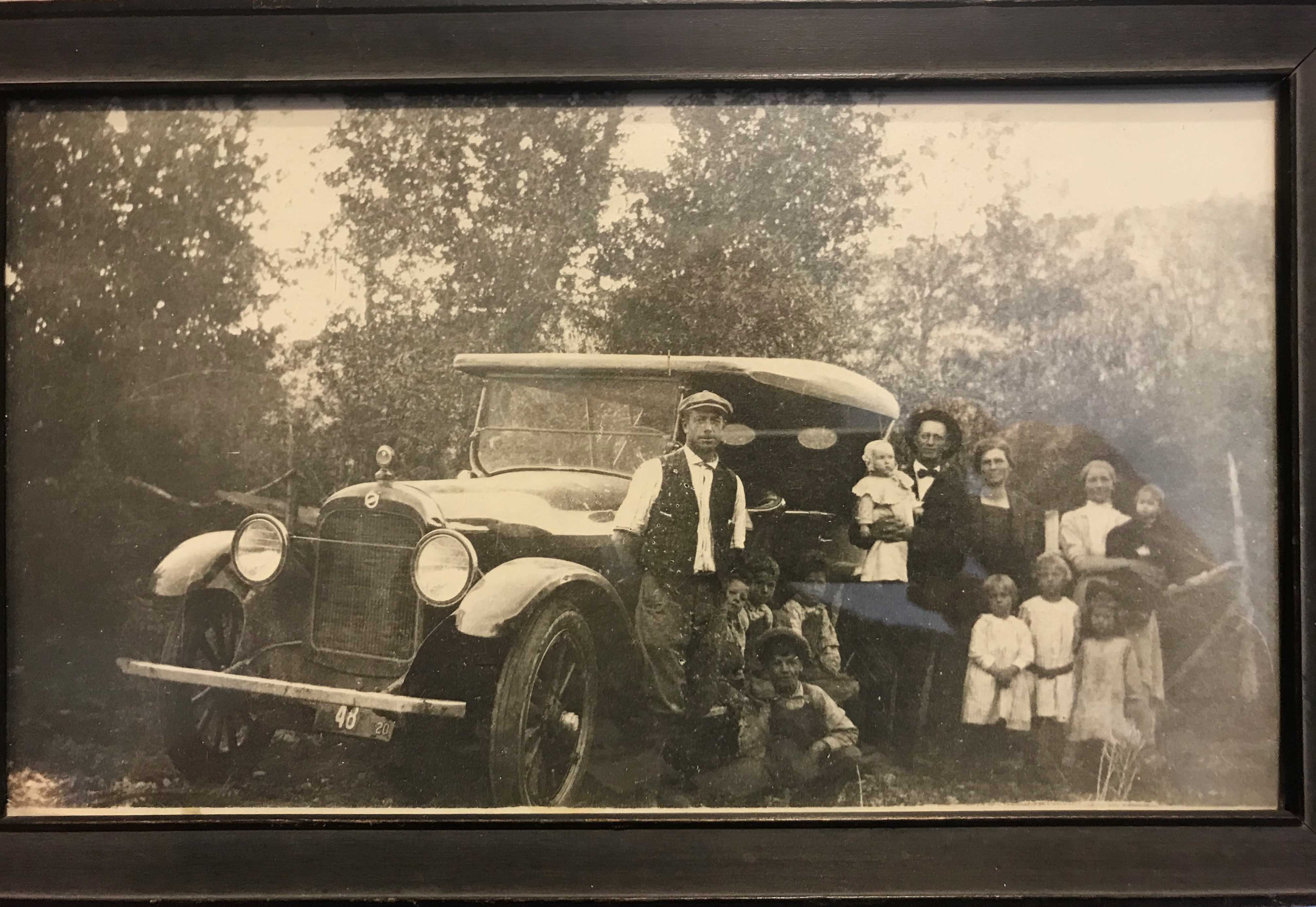Hello again, my web friends. Recently, I decided to find out a little more about a cherished family picture I’ve looked at for years.

The photo above is of Albert Robinson with four of his children. My Grandfather Elmer Carling (1887-1954) is holding my father Gerald (1919- 1991). It was the style to dress newborns as girls in them days. My grandmother Christa (1886-1954) is standing next to him, and I think the three children in white may be Clora 3, June 7, and Wanda 5. The lady in white is Albert’s wife Catherine holding their 5th child. The photo appears to have been taken up Chalk Creek above Fillmore, Utah.
I asked a knowledgeable car friend and writer, John Clark for some help. John publishes the series MOTOR TALES, www.motortales.com, about early Utah motoring and is also THE expert on Utah license plates. He was tasked by Gov. Huntsman to help design the new Utah plates back in 2007.

John immediately I. D.’d the car as a 1919 STUDEBAKER and pointed out that the plate has the low number 48, which indicates it was a dealer plate used for demonstration rides with prospective customers. The small number 20 indicates the plate was current in 1920.

John suggested I visit the Utah State Historical Archives in the Rio Grande building for further info.
A great resource and friendly people. They supplied pictures of a 1919 Stude as well as the later 1920 model. Sure as shootin’ the car in the picture is a 1919 Studebaker.
Notice the front bumper of the ’19 has two horizontal bars, probably of spring steel, but the bumper in my picture looks like a piece of wood. . Maybe one of those test drives didn’t turn out so well. The wood is somehow being held in place on the frame horns, but I don’t think baling wire and duct tape were invented yet. Destroying the front bumper may also explain why part of the plate right above the 20 seems to be missing. Ouch.
The Archives also supplied me with a shot of a 1920 Stude.

Notice it is the first year of all steel wheels, no more wooden spokes.
Being the curious sort, I wanted to find out more about Studebaker history.
Stutenbecker was a family of German metal workers from Solingen, Germany who immigrated in 1736 and settled in South Bend, Indiana. One of the brothers returned home after hitting it big in the California gold fields making wheelbarrows and other tools. In the 1850’s the family geared up and started making wagons. They were the largest manufacturer of wagons in the U.S. by 1876. When they switched to automobiles in 1902, their first cars were electric, but in 1904 they changed to gasoline. Wilson Motors in Richfield was the Stude dealer closest to Fillmore in 1920.

Grandfather Elmer was town marshall and the now-one-year-old 1919 Stude was possibly being marketed as a used car, following the unfortunate front bumper incident. Warner Motors, the Ford dealer in Fillmore, may have been the sales agent.
Ford’s Model T commanded 40% of the market, and a 4-door Touring Car sold for about $400.00 ($5,000 in today’s money). Stude was number 3 in sales, after the now forgotten Overland brand, and was priced about the same as the Ford. The 4-door Touring was the only model Stude offered.
Prohibition hit in 1920, and Stude became very popular with bootleggers because it was bigger and faster than the 4-cylinder Fords. The 354 cu.in. “Light 6” could do an honest 80 M.P.H. (I presume with the windshield and the top folded down). Brakes unfortunately were expanding drums on the rear only. At the time there were less than 100 miles of paved roads in Utah. With fabric cord tires, wooden wheels, dirt roads, and wishful brakes, those bootleggers really had to want to get away!
There may a be a back storyhere: A dark and stormy night, illegal booze, a desperate chase, a terrifying crash, arrested and jailed by the Town Marshall, and the car being confiscated and sold! Or maybe not.

The family picture is 6 ½ X 11 ½ and appears to be professionally done. Back then the negative was usually the same size as the picture, which meant cameras were quite large. Contact printing produced the positive. A sticker on the back says WHITE HOUSE, which according to Google was an upscale (Deluxe) 3-story “fireproof” hotel on Main St. in Salt Lake City. Perhaps they offered photography and picture framing also.

if a picture can tell a story, this old family photo tells several. Thanks to Albert, Elmer, Christa & Catherine for this fun family story.

Mr. Carling thanks for another fun and interesting story…loved it!
I have a picture of my father standing in front of a 1940 oldsmobile which he always told me was the greatest car he ever owned. Thank goodness we have old photos.